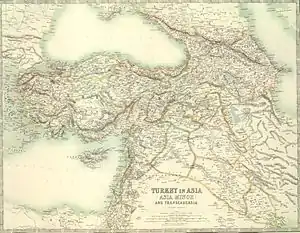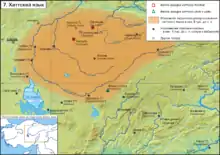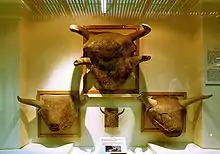Hattians
The Hattians (/ˈhætiənz/) were an ancient Bronze Age people, that inhabited the land of Hatti, in central Anatolia (modern Turkey). They spoke a distinctive Hattian language, that was neither Semitic or Indo-European. Hattians are attested by archeological records from the Early Bronze Age, and also by historical references in later Hittite and other sources. Their main center was the city of Hattush. Faced with Hittite expansion (since c. 2000 BCE), Hattians were gradually absorbed (by c. 1700 BCE) into the new political and social order, imposed by Hittites, who kept the country name ("land of Hatti"), that also became the main designation for the Hittite state.[1][2][3]
Part of a series on the |
|---|
| History of Turkey |
 |
|
|
Terminology

Complex questions related to etymology of endonymic terms for Hattians, their land, language and capital city (Hatti, Hattili, Hattush) are debated among scholars. Later conquerors (Hittites) did not change the name of the city (Hattush). They also adopted the regional name (Land of Hatti), and even expanded its use, transforming it into the most common designation for their entire country, that grew to be much larger than the land of ancient Hattians.[4]
It is therefore assumed that Hattian designations had some special significance already during the pre-Hittite period, and it is also accepted, as a convention among scholars, that Hattian labels can be used as designations for pre-Hittite population of central Anatolia,[5] although it is not known whether ethically related inhabitants of neighboring regions and city-states (surrounding the city-state of Hattush) ever saw themselves as Hattians.
The use of the term "Proto-Hittite" as a designation for Hattians is inaccurate. Hittite language (natively known as Nešili, "[in the language] of Neša") is an Indo-European language, linguistically distinct from Hattian language. The Hittites continued to use the term Land of Hatti for their own state. The Hattians eventually merged with people who spoke Indo-European languages like Hittite, Luwian, and Palaic.
History

Several archeological sites in central Anatolia, dating from the Early Bronze Age (second half of the 3rd millennia BCE) are attributed to ancient Hattians. The structure of archeological finds in some sites, like Hattush, reveal the existence of a highly developed culture, with distinct social stratification. Most scholars believe that first Hattian states existed already during the period of the Akkadian Empire. That assumption is based on some later sources, mainly Hittite and Assyrian. The epic known as the "King of Battle" (recorded in several versions from the 14th century BCE onward) narrates about a war between Sargon the Great of Akkad (24th-23rd century BCE) and king Nur-Daggal of Purushanda, but those events are not attested in contemporary sources, that would date from the period of the Akkadian Empire.[6][7]
A Hittite version (from c. 1400 BCE) of an older Akkadian story, also narrates some events that are related to early times, taking place during the rule of king Naram-Sin of Akad (23rd century BCE). The story describes a conflict between Naram-Sin and an alliance of 17 kings. The Hittite version of that story includes Pamba of Hatti among those kings, but that inclusion is not attested in Akkadian versions of the story, nor in contemporary sources, that would date from the period of the Akkadian Empire. Some scholars hold that Hittite version (from c. 1400 BCE) can be accepted as reliable and derived from some local sources. In that case, the narrative would contain a trustworthy tradition, thus providing a base for an assumption that the ancient Kingdom of Hatti existed already during the period of the Akkadian Empire.[8][9][10][11]
The Hattians were organized in monarchical city-states. These states were ruled as theocratic kingdoms or principalities. Hattian regions of Anatolia came to be influenced by mighty Mesopotamian polities, in the form the Akkadian Empire (24th-22nd century BCE) and the succeeding Old Assyrian Empire (21st-18th century BCE), both of which set up trading colonies called karum, located throughout eastern and central Anatolia. During the first centuries of the 2nd millennium BCE, an Assyrian trade colony existed in the city of Hattush, and several Assyrian inscriptions mention (usually by office, not by name) the existence of local rulers (kings) of Hattush, also referring to their relations with other city-states in the region.[12]
Language

Hattians spoke Hattian language, a non-Indo-European and non-Semitic language of uncertain affiliation. Hattian is now believed by some scholars to be related to the Northwest Caucasian language group.[13] Trevor Bryce writes:
Evidence of a 'Hattic' civilization is provided by the remnants of one of the non-Indo-European languages found in the later Hittite archives.The language is identified in several of the texts in which it appears by the term hattili- '(written) in the language of Hatti.' The few texts that survive are predominantly religious or cultic in character. They provide us with the names of a number of Hattic deities, as well as Hattic personal and place-names.[14]
About 150 short specimens of Hattian text have been found in Hittite cuneiform clay tablets. Hattian leaders perhaps used scribes who wrote in Old Assyrian. Ekrem Akurgal wrote, "the Anatolian princes used scribes knowing Assyrian for commerce with Mesopotomia as at Kanesh (Kültepe)" to conduct business with Assyria.[15] From the 21st to the mid-18th centuries BC, Assyria established trade outposts in Hatti, such as at Hattum and Zalpa.
Scholars have long assumed that the predominant population of the region of Anatolia "in the third millennium [BC] was an indigenous pre-Indo-European group called the Hattians." Another non-Indo-European group were the Hurrians.[16] But it is thought possible that speakers of Indo-European languages were also in central Anatolia by then. The scholar Petra Goedegebuure has proposed that before the conquest of the Hittites, an Indo-European language, probably Luwian, had already been spoken alongside the Hattian language for a long time.[17]
Hattian became more ergative towards the New Hittite period. This development implies that Hattian remained alive until at least the end of the 14th century BC.[18]
Alexei Kassian proposed that the Northwest Caucasian languages (also known as Abkhazo-Adyghe), which are syntactically subject–object–verb, had lexical contacts with Hattian.[19]
Religion

Hattian religion traces back to the Stone Age. It involved worship of the earth, which is personified as a mother goddess; the Hattians honored the mother goddess to ensure their crops and their own well-being.[20] The Hattian pantheon of gods included the storm-god Taru (represented by a bull), the sun-goddess Furušemu or Wurunšemu (represented by a leopard), and a number of other elemental gods. Reliefs in Çatal Höyük show a female figure giving birth to a bull, i.e. the mother-goddess Kattahha (or Hannahanna) was mother to the storm-god Taru.
Later on the Hittites subsumed much of the Hattian pantheon into their own religious beliefs.[21] James Mellaart has proposed that the indigenous Anatolian religion revolved around a water-from-the-earth concept. Pictorial and written sources show that the deity of paramount importance to the inhabitants of Anatolia was the terrestrial water-god. Many gods are connected with the earth and water. In Hittite cuneiform, the terrestrial water god is generally represented with dIM. The storm gods of Anatolia were written with about one hundred catalogue variants of dU, mostly described as the Stormgod of Hatti or with a city name.[22][23]
The Hittite legends of Telipinu and the serpentine dragon Illuyanka found their origin in the Hattian civilization.[24]
Physiognomy
Some scholars thought that Hattians and Hittites had perhaps different personal characteristics, though most Anatolian societies in the Bronze Age were multi-lingual. Egyptian depictions of the Battle of Kadesh reportedly show long-nosed Hattian soldiers, while their Hittite leaders looked different according to Turkish archaeologist Ekrem Akurgal.[25] This claim is dubious however as the vast majority of contemporary depictions of Hittites show no phenotypical difference between Hittite elite and commoners.
See also
References
- Akurgal 2001, p. 4-6.
- Bryce 2005, p. 12-15.
- Bryce 2009, p. 297-298, 314.
- Bryce 2009, p. 297-298.
- Bryce 2014, p. 129.
- Akurgal 2001, p. 38.
- Bryce 2005, p. 25.
- Bryce 2005, p. 10.
- Bryce 2009, p. 297.
- Gilan 2010, p. 53.
- Gilan 2018, p. 7.
- Barjamovic 2011, p. 292-297.
- Burney 2004, p. 106-107.
- Bryce 2005, p. 12.
- Akurgal 2001, p. 5.
- Bryce 2005, p. 12-13.
- Petra Goedegebuure 2008 Central Anatolian Languages and Language Communities in the Colony Period: A Luwian-Hattian Symbiosis and the independent Hittites. OAAS volume 3 Leiden
- Published in Proceedings of the 53e Rencontre Assyriologique Internationale Vol. 1: Language in the Ancient Near East (2010)
- Kassian, Alexei. 2009. Ugarit Forschungen Band 41, 403
- C. Scott Littleton (2005). Gods, Goddesses, and Mythology. Marshall Cavendish. pp. 692–. ISBN 978-0-7614-7559-0. Retrieved 26 March 2013.
- Burney 2004, p. 106.
- Hutter, Manfred (1997). "Religion in Hittite Anatolia. Some Comments on "Volkert Haas: Geschichte der hethitischen Religion"". Numen. 44 (1): 74–90. JSTOR 3270383.
- Green, Alberto. R.W. (2003). The Storm-God in the Ancient Near East. Wioana Lake: Eisenbrauns. pp. 89–103. ISBN 978-1-57506-069-9.
- Akurgal 2001.
- Ekrem Akurgal, The Hattian and Hittite Civilizations, Publications of the Republic of Turkey: Ministry of Culture, 2001, p. 8 Akurgal writes here: "The large-nosed soldiers identified as "Hitti" in the Egyptian temple depictions of the Battle of Kadesh show a different ethnic type from their [Hittite Indo-European?] kings in the same scenes".
Sources
- Akurgal, Ekrem (2001). The Hattian and Hittite Civilizations. Ankara: Ministry of Culture.
- Barjamovic, Gojko (2011). A Historical Geography of Anatolia in the Old Assyrian Colony Period. Copenhagen: Museum Tusculanum Press.
- Beckman, Gary M. (2001). "Sargon and Naram-Sin in Ḫatti: Reflections of Mesopotamian Antiquity among the Hittites" (PDF). Die Gegenwart des Altertums: Formen und Funktionen des Altertumsbezugs in den Hochkulturen der Alten Welt. Heidelberg: Forum. pp. 85–91.
- Bryce, Trevor R. (2005) [1998]. The Kingdom of the Hittites (2nd revised ed.). New York: Oxford University Press.
- Bryce, Trevor R. (2009). The Routledge Handbook of the Peoples and Places of Ancient Western Asia: The Near East from the Early Bronze Age to the fall of the Persian Empire. London-New York: Routledge.
- Bryce, Trevor R. (2014). "Hittites and Anatolian Ethnic Diversity". A Companion to Ethnicity in the Ancient Mediterranean. Chichester: John Wiley & Sons. pp. 127–141.
- Burney, Charles A. (2004). Historical Dictionary of the Hittites. Lanham: Scarecrow Press.
- Gilan, Amir (2010). "Epic and History in Hittite Anatolia: In Search of a Local Hero". Epic and History. Chichester: John Wiley & Sons. pp. 51–65.
- Gilan, Amir (2018). "In Search of a Distant Past: Forms of Historical Consciousness in Hittite Anatolia" (PDF). Anadolu. 44: 1–23.
External links
| Wikimedia Commons has media related to Hattians. |

